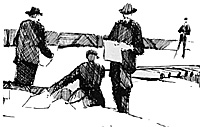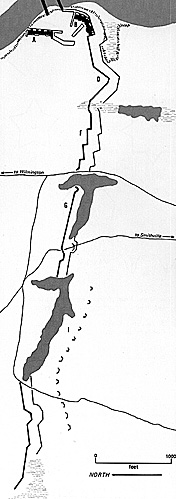 To it (engineering) is entrusted the most difficult of all tasks assigned to the soldier.
To it (engineering) is entrusted the most difficult of all tasks assigned to the soldier.
The role of engineers, in both the Civil and Napoleonic Wars, was basically to create passage through material barriers and the placing or removing of passive obstacles meant to block an attack. The engineers also had the duties of fortifying positions of the army in the field. Officers holding the commission of engineer were even assigned to command staffs with responsibilities of reconnaissance and selecting routes of march in addition to their regular duties. The fulfillment of these duties required a good deal of versatility in both wars.
The French engineers had a particularly good reputation for bridging and fortifying. The passage of the Danube on July 3, 1809, and particularly the crossing of the Beresina in 1812 during the desperate retreat from Russia were viewed as outstanding examples of pontoon bridging. With reference to fortifying, General Foy remarked, "All Europe has been covered by our redoubts and entrenchments."
Like the French engineers, the army engineers of the United States fou~nd themselves in increasing demand as the Civil War went on. They started with a few enlisted men and a handful of officers, so the constant and increasing need for bridging and fortifying put them in great demand. The North was very fortunate in this regard. Most of the officers and men who were trained engineers were already assigned to these duties and remained in the ranks readily available as needed.
In the South, the Confederates found themselves with an inferior organization of engineers up until 1863. Although many of the southern officers were skilled civilian engineers, their experience in the military was limited. In addition, the Confederates were hampered because there never seemed to be enough spare manpower to fill the ranks of the pioneer corps of the engineers. This shortage became so acute that, on one occasion at Drury's Bluff, the Provost Marshall had to impress 500 civilians for work on the fortifications.
When the Civil War engineers entered the field, they discovered the enormity of the task set before them. The theater of operations was often wooded and bisected by many rivers of various sizes. The few bridges that did exist were most likely destroyed early in the war. In addition, the average country road was hardly more than a cow path and when it rained these "roads" turned into what seemed to be bottomless wallows of mud.
Crossing these natural obstacles was no easy matter. Muddy roads often had to be planked over and made into what was called a corduroy road. Roads often needed to be widened and much of the wilderness had to be mapped. It seems simple today to drive through a swamp or over a bridge, but in 1862 it required a good deal of clearing, mapping and bridging to move an army through a wilderness.
When the army came to an unfordable river, the pontooners were called upon to build a hasty bridge. This delicate operation was accomplished by first anchoring a row of pontoons across the river. Then the pontooners would lash beams diagonally between all the pontoons. Finally, planks were laid over the lashed beams and the bridge was ready. This process seems simple, but it was often extremely difficult. Naturally the enemy didn't allow the engineers to build their bridges without opposition. At Fredericksburg, the Confederates had stationed a number of sharpshooters who fired on and killed many an engineer building the bridge.
The art of fortifying, like bridging, was also in great demand. During the early part of the war relatively few fieldworks were undertaken by a campaigning army. Fortifying camps or positions was considered a waste of time by many officers since, no doubt, the army would move before the enemy appeared. At Shiloh, this folly was disproved and the need for fortified positions made abundantly clear when Grant's army was taken by surprise and given a rough handling in their unfortified camps. As the war progressed, the tendency increased to fortify camps and positions when near the enemy. By 1864, it seemed as though every time an army moved it prepared breastworks. Usually these works were of a temporary nature but they could be quite formidable at times.
When more permanent fortifications were needed, the engineers could be counted upon to turn the position into a redoubt in a short while. The standard procedure was to dig a seven-foot-deep ditch and pile the earth into a thick parapet directly behind the trench. Once the parapet was completed, a shorter bank of earth called the glacis was constructed on the side of the ditch facing the enemy. Finally the fortifiers would form what was called the abatis, a maze of ditches, sharpened stakes and fallen trees, which were designed to entangle attacking troops. Once the fortifications were complete, it became extremely difficult to assault these works directly. One officer at Petersburg remarked that, "We have had enough of assaulting earthworks. We simply ran toward the enemy and then ran back."
If the abatis, ditches and parapets weren't enough, the engineers often laid their earthworks out so that crossfires could be aimed against attacking troops entangled in the abatis. If the attacker was fortunate enough to get through the abatis and into the ditch, the defenders often had a fieldpiece packed with canister aiming right down the length of the ditch from another location in the earthwork. If all else failed, the defending infantry would fix bayonets and launch themselves over the parapet and onto the attackers in the ditch. Most of the time the fresh defenders would then confront a decimated and demoralized attacker.
When confronted with such formidable earthworks, the attackers had, basically, four options. The first option was to maneuver around the entrenchments. Many times this was not practical because the defenders frequently enjoyed the advantage of interior lines. Wherever the attackers moved, these lines enabled the defenders to travel a shorter distance and dig in because they were nearer to the attacker's goal. Grant faced this dilemma in Virginia. Everytime he moved, whether to Spottsylvania, Cold Harbor or Petersburg, Lee was there in force and entrenched.
 Map for Fort Anderson, North Carolina: Feb. 14, 1865
Map for Fort Anderson, North Carolina: Feb. 14, 1865
At right: Note the covered water batteries (A) and (B); simple redan (D) with 32-pounder batteries; indented line (F); simple curtain with artillery (C). Also note its advanced rifle pits (1) whose job it was to skirmish and harass the attacking sappers as they advanced. If the forward pits were taken in a rush of force, the skirmishers fell back while harassing the attackers.
Jumbo Map of Fort Anderson (75K)
Storm
The second option was to storm the earthworks. This practice often consumed the least time although it often brought the most casualties. The theory of this attack was to bring heavy rifled pieces into position on commanding heights above the entrenched enemy. These were concentrated upon the exposed and weakest section of the line in an effort to silence the enemy's artillery, flatten the parapets and disorganize the defending infantry. Engineers detailed into sapping groups would then advance under cover of a preparatory artillery barrage. Sapping parties would advance with large baskets filled with earth called sap rolles. The sap rollers were used to fill the ditches of the abatis. Lastly, the engineers would clear a path through the abatis entanglements. The attacking infantry would then form in deep columns and storm the position.
Since this theory of attack was developed during the age of the flintlock, as could be expected, its effectiveness decreased greatly with the rifled weaponry. At Fredericksburg the old storming tactics against th e new rifle-musket resulted in the predictable, 7000 dead and not one organized unit got nearer than 100 yards to the Confederate position.
The best method of carrying entrenched positions was mining. Mining was rarely used because it was often difficult, on occasion the shafts were known to collapse and it was liable to countermining. One of the great exceptions to this rule occurred at Petersburg in 1864. Here Colonel Pleasants and the 48th Pennsylvania Infantry dug a 510-foot-long tunnel to a Confederate fort. Four tons of powder was emplaced and "detonated with an explosion resembling a volcano." The blast made a 500-yard gap in the confederate line and opened the way to Petersburg. Unfortunately, the attack was mishandled and received a bloodly repulse at the crater.
The last option was the besieging of the enemy emplacements. This method was only resorted to after a direct assault or counter maneuvering had failed. Frequently this involved both sides building an abatis, a parapet and several deep ditches. This was the precise method employed at Petersburg in 1864 when Grant failed to outmaneuver Lee. Here the siege lasted for months until the Confederates were worn down, their lines were overextended and finally breached by an assault.
The rifle-musket and other new rifled arms were deeply affecting fortifications. The improved firepower of the new rifle-musket and the rifled artillery was, in fact, aiding the entrenched defendes. Carrying a position was simply becoming too difficult. Although the Civil War brought few changes to the engineering art, the power of the new weapons increased the effectiveness and use of earthworks. Assaulting prepared positions was often far too costly under the devastating fire of the rifle-musket. Under most conditions mining was not practical because it was far too hazardous.
Even flanking the prepared position too often proved fruitless for the defendes many times enjoyed interior lines. The only practical altemative left was to besiege the enemy with a heavy fire in hopes of sapping his strength. As with the other arms, the art of defensive engineering was gaining a decided advantage over the attacker.
More ACW Rifle-Musket
-
ACW: Introduction
ACW: Infantry
ACW: Infantry Tactics (Examples)
ACW: Cavalry
ACW: Artillery
ACW: Engineers
ACW: Entrenchments
ACW: Grand Tactics
ACW: Tactics: Auerstadt 1806 vs. New Market 1864
ACW: Conclusion and Bibliography
Back to Conflict Number 7 Table of Contents
Back to Conflict List of Issues
Back to MagWeb Master Magazine List
© Copyright 1974 by Dana Lombardy
This article appears in MagWeb (Magazine Web) on the Internet World Wide Web.
Other military history articles and gaming articles are available at http://www.magweb.com